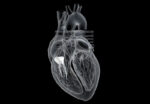Severe mitral disease is common and currently constitutes a frequent cause of hospitalization and death. While surgery is the treatment of choice, transcatheter mitral valve replacement (TMVR) emerges as a valid alternative in cases of bioprosthesis failure, ring malfunction, or severe mitral annular calcification (MAC). Furthermore, the latest medical guidelines support the recommendation of TMVR...
Use of Apixaban and Post TAVR Valve Thrombosis
TAVR can be associated to early valve thrombosis, characterized by thrombi formation near or attached to the prosthetic valve, with or without valve dysfunction. This dysfunction is associated with increased leaf thickening and reduced leaflet motion, as well as reduced orifice area or increased transvalvular gradient. Triggered multislice CT allows dynamic valve assessment and thrombosis...
Intramural Hematoma
Intramural hematoma (IMH) is considered a subtype of acute aortic syndrome (AAS), and some authors describe it as a developmental stage that might cause high morbimortality events such as dissection, aneurysm, or aortic rupture. One of the CT findings associated with IMH is focal contrast enhancement (FCE) within the intramural hematoma, with a reported incidence...
Relationship of Radial Wall Strain with Functional and Morphological Assessment of Coronary Artery Lesions
Radial wall strain (RWS) has been recently linked with plaque vulnerability and has been identified as a predictor of lesion progression and clinical outcomes. However, RWS should be assessed together with physiological indices and plaque characteristics. The aim of this post hoc analysis of the CCTA-FFR registry was to look into the link between RWS...
Use of Intravascular Lithotripsy vs. Rotational Atherectomy for Severely Calcified Coronary Lesions
Severely calcified coronary stenosis poses a significant challenge for coronary angioplasty procedures. Modifying plaque before stenting is crucial to a successful intervention, since it will prevent the sub expansion associated to worse clinical outcomes at followup. The tools employed to assess complex lesions include specialized balloons such as cutting, scoring, or high pressure balloons, as...
LIFE-BTK | Critical Limb Ischemia: Use of Bioresorbable Scaffold in Infrapatellar Lesions (LIFE-BTK)
Advanced stages of peripheral artery disease cause significant limitations in patients, such as critical limb ischemia (CLI), which manifests with resting pain and gangrene or ulcers of difficult resolution. Uncontrolled progression of this pathology might lead to major amputation, reduced life expectancy and increased healthcare costs. Prior research on infrapopliteal territory have shown contradicting results....
Long-term Results of Coronary Bifurcation Lesion Treatment in Diabetic Patients
The effects of diabetes on patients with coronary artery disease are well-known, and their outcomes after angioplasty are less favorable, with a higher rate of restenosis, recurrent acute myocardial infarction, and stent thrombosis. Despite advances in drug-eluting stents and procedural techniques, the treatment of coronary bifurcation lesions in diabetic patients shows less positive clinical outcomes...
TricValve: 12-Month Evolution
Tricuspid regurgitation has become increasingly common, and current pharmacological treatment options are limited. In turn, surgery, which is a complex alternative, carries considerable rates of complications and mortality. In response to this issue, various percutaneous systems are being developed, such as edge-to-edge treatment, percutaneous annuloplasty, and caval valve implantation (CAVI), among others. In the analysis...
Health Status Scores after Transcatheter Repair in Patients with Tricuspid Regurgitation: TRILUMINATE Analysis
Severe tricuspid regurgitation (TR) has been associated with higher mortality and significant limitations to patient quality of life, with considerable rates of hospitalization for cardiac failure (CF). Transcatheter edge-to-edge repair (TEER) with TriClip has been shown effective to reduce symptoms, with low risk of periprocedural complications. The aim of this study was to assess functional...
Structural Summit 2024: Disruptive Innovations, Complex Interventions
An event of great significance for interventional cardiology in South America is coming soon: the Structural Summit 2024, organized jointly by the Brazilian Society of Hemodynamics and Interventional Cardiology (SBHCI), SOLACI, and CRF/TVT. This important scientific activity will take place from February 28 to March 1, 2024, at the Unique Hotel in São Paulo, Brazil,...









